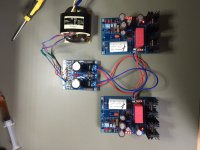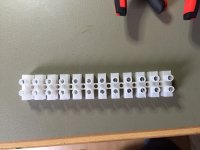When ordering the specific R-Core for the FSP get the 15V+15V model that will give 17V+17V at such loading and on 230VAC for a nice raw DC level without further manipulation needed as I wrote before
Yesssss
Thanks for the tip! 😀
Yes, listen and do as Salas tels you 😀
Regards
Thanks for the tip! 😀
the primary resistance is quite a bit lower than I guessed it might be.............Resistance on primary 42.9 Ohm
.............IPrimary 0.001MA(could be nothing because my MM says the same unconnected. it goes to this number after 1 minute)............
It looks like you used your ammeter in the Mains line.That is dangerous.
Don't.
Found some 22 Ohm 20Watt precision resistors on a heatsink.... Used them in paralel for dummy load a long time ago. Those will do better than the 100 Ohm ones I put in now.....
Measuring Amps
Hi Andrew,
Why is that dangerous? I would like to learn😱
the primary resistance is quite a bit lower than I guessed it might be.
It looks like you used your ammeter in the Mains line.That is dangerous.
Don't.
Hi Andrew,
Why is that dangerous? I would like to learn😱
The ammeter and it's leads/probes are at Mains Voltage.
Dare you risk touching the scale setting buttons?
How do you prevent the probe attachments being touched by other components?
That method increases the areas of potential shock from a piece of double insulated cable to a string of exposed leads and connectors and instument.
Dare you risk touching the scale setting buttons?
How do you prevent the probe attachments being touched by other components?
That method increases the areas of potential shock from a piece of double insulated cable to a string of exposed leads and connectors and instument.
Kroonsteen
Hi Andrew,
I connect the leads with kroonsteen..... don't know the englisch name for it... see pic. So nothing can touch the leads.
Then, before applying power, I scale the right way. So, if this is done the right way I don't see the danger.... But you are right. Care is very important!
Hi Andrew,
I connect the leads with kroonsteen..... don't know the englisch name for it... see pic. So nothing can touch the leads.
Then, before applying power, I scale the right way. So, if this is done the right way I don't see the danger.... But you are right. Care is very important!
Attachments
Ok, looks good!
Rail 1 = 31.22 VDC
Rail 2 = 32.53 VDC
TP 1 / TP 2 both 3.600 exact.
Warming up.....
Rail 1 = 31.22 VDC
Rail 2 = 32.53 VDC
TP 1 / TP 2 both 3.600 exact.
Warming up.....
After power on the whole afternoon I had to adjust a little.
Rails are now 31.25 and 31.55 VDC. Both TP1 / TP2 are now steady for two hours straight at 3.600 VDC.
I guess it's time to give these parts their home 🙂
For umbillical cord from Powerbox to Amp box I will use Neutrik 5 pole XLR connectors. I guess that should be fine.
Rails are now 31.25 and 31.55 VDC. Both TP1 / TP2 are now steady for two hours straight at 3.600 VDC.
I guess it's time to give these parts their home 🙂
For umbillical cord from Powerbox to Amp box I will use Neutrik 5 pole XLR connectors. I guess that should be fine.
Nice. Give ti some hours of audio play when ready for its electrolytics to flex from storage sleep.
Both boards warming up @ 3.60VDC Bias.
Looking good so far!
You only got one R-Core for two channels?
I connect the leads with kroonsteen..... don't know the englisch name for it... see pic. So nothing can touch the leads.
Screw terminals or barrier strips
Yes, I have one R-core. Is that not ok?
Raw DC without load was 51,5Vdc. With both channels connected 43Vdc.
I am getting the feeling I have to buy another trannie?
Thanks for the Enlish lesson 🙂
Raw DC without load was 51,5Vdc. With both channels connected 43Vdc.
I am getting the feeling I have to buy another trannie?
Thanks for the Enlish lesson 🙂
Optimal is to buy one more. Now you are using one with secondaries in series for two bridges. I haven't used that configuration I hope it will not hum. People either used one Tx with separate >30V AC secondaries or two Tx with high enough single secondary/double low combined in series, feeding each AC in on the raw PCB separately.
- Home
- Source & Line
- Analogue Source
- Simplistic NJFET RIAA

